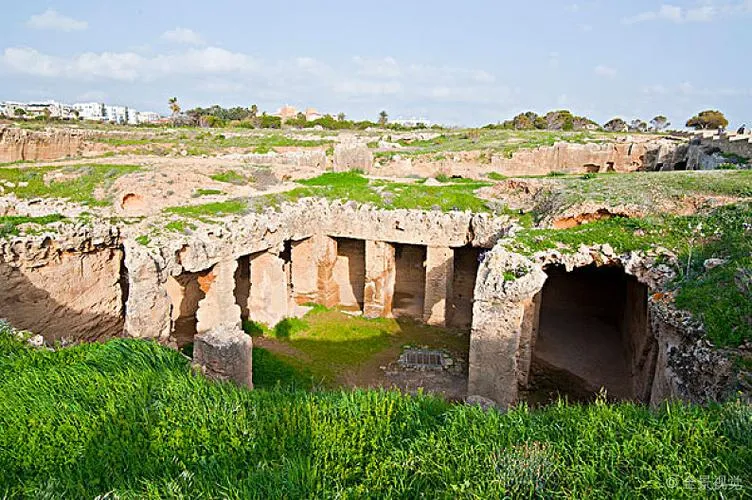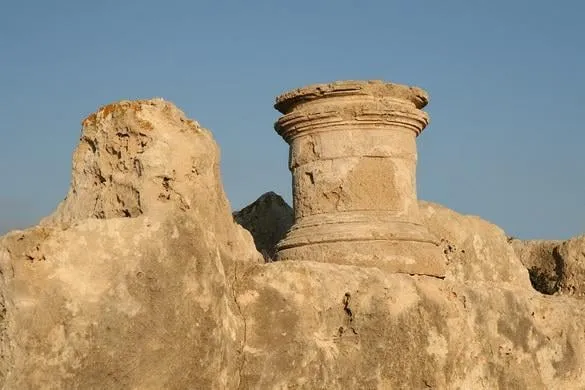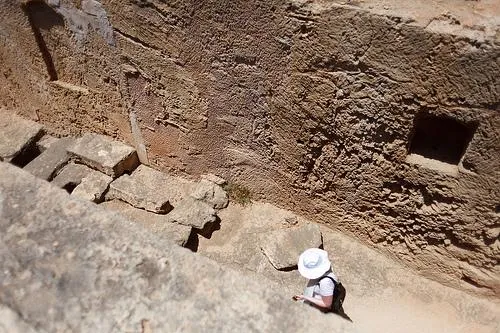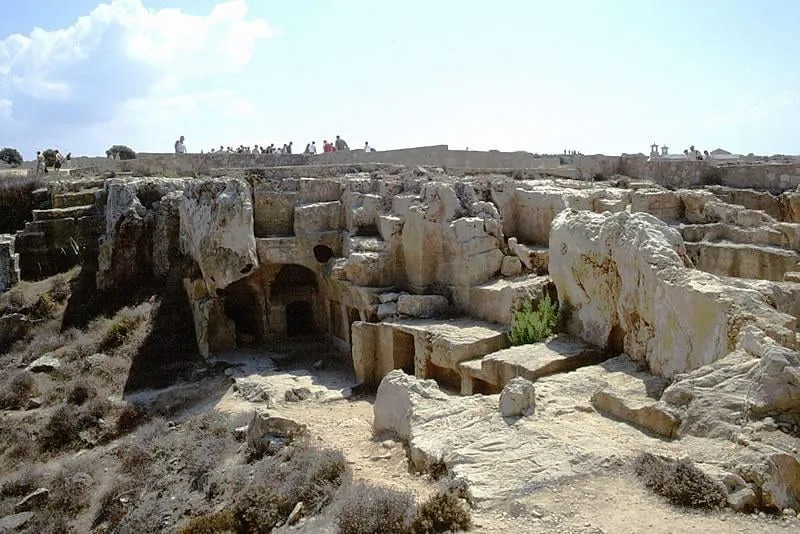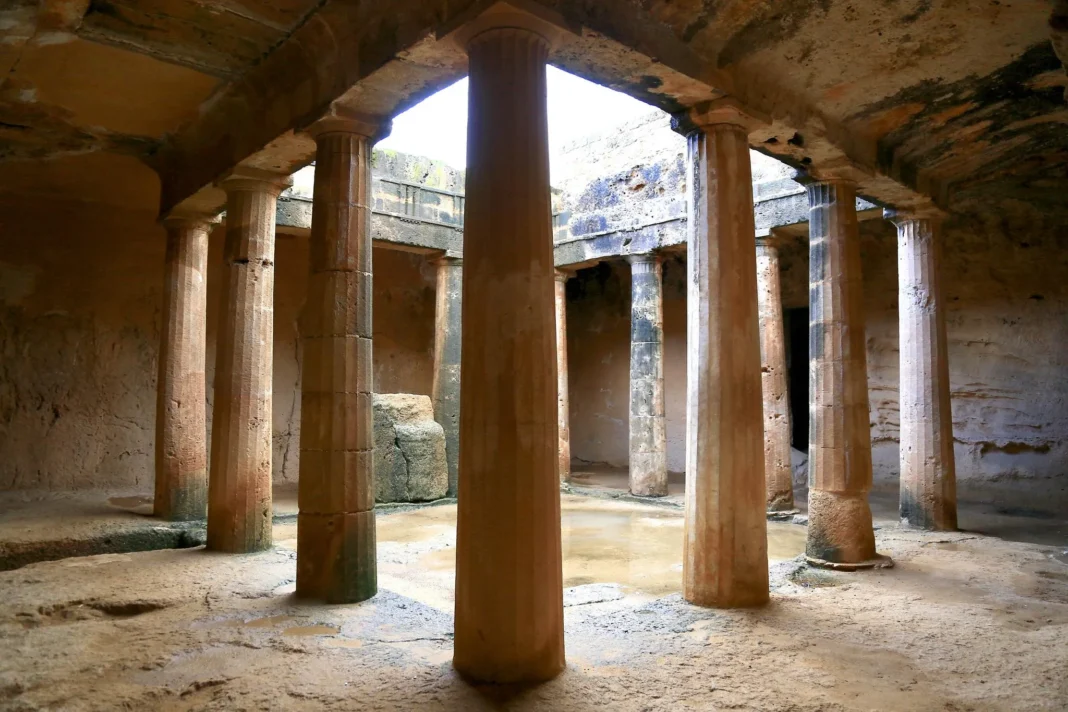The Tombs of the Kings, a sprawling necropolis near Paphos, Cyprus, stands as a testament to the island’s rich history and cultural heritage. This UNESCO World Heritage Site, dating back to the 4th century BC, offers a fascinating glimpse into the lives and beliefs of the ancient Cypriots.
Despite its name, the Tombs of the Kings were not the final resting place of royalty. Instead, they housed high-ranking officials, aristocrats, and other prominent figures of the Hellenistic and Roman periods. The tombs’ grandeur and architectural complexity reflect the wealth and status of those interred within.
Exploring the Tombs of the Kings
The Tombs of the Kings is a vast archaeological site, covering an area of approximately 13 hectares. The necropolis comprises numerous underground tombs carved into the solid rock, each with its unique layout and features. As you wander through the site, you’ll encounter:
- Monumental Tombs: Some tombs are grand and elaborate, featuring Doric columns, peristyles, and intricate frescoes. These tombs showcase the Hellenistic influence on Cypriot architecture and art.
- Family Tombs: Many tombs were designed to accommodate multiple burials, often spanning several generations. These family tombs provide insights into the social structures and kinship ties of ancient Cyprus.
- Simple Chamber Tombs: Not all tombs are extravagant. Some are simple chambers with minimal decoration, reflecting the varying social statuses of those interred.
- Atria and Courtyards: Several tombs feature open-air atria or courtyards, where rituals and ceremonies related to the deceased may have taken place.
Key Features of the Tombs
The Tombs of the Kings boast several architectural and artistic elements that make them a unique and captivating historical site. Some of the key features include:
- Doric Columns: Many tombs feature Doric columns, a hallmark of Hellenistic architecture. These columns add a sense of grandeur and elegance to the structures.
- Peristyles: Some tombs incorporate peristyles, or columned porticos, surrounding a central courtyard. These open spaces provided light and ventilation to the underground chambers.
- Frescoes: Although faded and fragmented, traces of frescoes can still be seen in some tombs. These paintings offer glimpses into the artistic styles and religious beliefs of the ancient Cypriots.
- Carvings and Inscriptions: Some tombs feature carvings and inscriptions that provide clues about the identity and social status of the deceased.
A Walk Through History
As you explore the Tombs of the Kings, you’ll embark on a journey through time, witnessing the evolution of Cypriot funerary practices and architectural styles. Here’s a suggested itinerary for your visit:
- Entrance and Orientation: Start your visit at the main entrance, where you can purchase tickets and obtain a map of the site. Take a moment to orient yourself and plan your route through the necropolis.
- Tomb 3: Begin your exploration with Tomb 3, one of the most impressive and well-preserved tombs in the complex. This monumental tomb features a grand Doric colonnade, a peristyle courtyard, and several underground chambers.
- Tomb 4: Next, visit Tomb 4, another significant tomb known for its architectural complexity. This tomb boasts a unique atrium with a central rock-cut staircase leading to the burial chambers.
- Tomb 7: Continue your journey to Tomb 7, a family tomb with multiple chambers and connecting passages. This tomb provides insights into the kinship ties and burial practices of ancient Cypriot families.
- Other Tombs: Explore other tombs of interest, such as Tomb 8, known for its Doric columns and peristyle, and Tomb 11, a simple chamber tomb with minimal decoration.
- Scenic Views: As you wander through the site, take in the scenic views of the surrounding landscape, including the Mediterranean Sea and the modern city of Paphos.
- Reflection and Contemplation: Conclude your visit with a moment of reflection and contemplation, appreciating the historical significance and cultural richness of the Tombs of the Kings.
Tips for Visiting the Tombs of the Kings
To make the most of your visit to the Tombs of the Kings, consider the following tips:
- Wear comfortable shoes: The site is extensive, and you’ll be doing a lot of walking, so wear comfortable shoes.
- Bring sunscreen and a hat: The Cyprus sun can be strong, so protect yourself from sunburn.
- Carry water: It’s important to stay hydrated, especially during the hot summer months.
- Allow ample time: Allocate at least 2-3 hours to explore the site thoroughly.
- Consider a guided tour: A guided tour can provide valuable insights into the history and significance of the tombs.
- Respect the site: Avoid touching the tombs or artifacts, and refrain from littering.
Frequently Asked Questions
Q: What is the history of the Tombs of the Kings?
A: The Tombs of the Kings date back to the 4th century BC and were used for burials until the 3rd century AD. Despite their name, they housed high-ranking officials, aristocrats, and other prominent figures, not royalty.
Q: Why are the Tombs of the Kings a UNESCO World Heritage Site?
A: The Tombs of the Kings are recognized as a UNESCO World Heritage Site for their outstanding universal value. They represent a unique and well-preserved example of ancient funerary architecture and provide insights into the cultural and social practices of the Hellenistic and Roman periods in Cyprus.
Q: How much does it cost to visit the Tombs of the Kings?
A: The entrance fee is €2.50 for adults and €1.25 for children.
Q: What is the best time of year to visit the Tombs of the Kings?
A: The best time to visit is during the shoulder seasons of spring (April-May) and autumn (September-October) when the weather is pleasant and there are fewer crowds. Summer (June-August) can be hot, so be sure to bring plenty of water and sunscreen.
Q: Are there any guided tours available?
A: Yes, there are several companies that offer guided tours of the Tombs of the Kings. These tours can provide valuable insights into the history and significance of the site.
Q: Can I take photographs inside the tombs?
A: Yes, you can take photographs inside the tombs, but flash photography is not permitted.
Beyond the Tombs: Exploring Paphos
While the Tombs of the Kings are undoubtedly a highlight of any visit to Paphos, the city offers much more to explore. Here are a few suggestions:
- Paphos Archaeological Park: This UNESCO World Heritage Site showcases a wealth of ancient ruins, including the House of Dionysos, the Odeon, and the Saranta Kolones Castle.
- Kato Paphos Harbor: This picturesque harbor is lined with restaurants, cafes, and shops. It’s a great place to relax and enjoy the Mediterranean atmosphere.
- Paphos Castle: This medieval castle, located at the harbor’s edge, offers stunning views of the coastline.
- Aphrodite’s Rock: According to legend, this sea stack is the birthplace of the goddess Aphrodite. It’s a popular spot for swimming and sunbathing.
Conclusion
The Tombs of the Kings offer a captivating journey into Cyprus’s ancient past. As you explore this UNESCO World Heritage Site, you’ll be transported back in time, witnessing the grandeur and architectural prowess of the Hellenistic and Roman periods.
The tombs’ intricate details, from Doric columns to faded frescoes, tell stories of wealth, power, and the enduring human desire to commemorate the deceased. A visit to the Tombs of the Kings is not just a sightseeing trip; it’s an opportunity to connect with the island’s rich history and cultural heritage.


